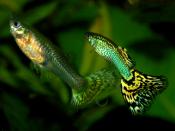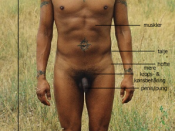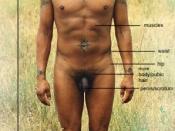Nov. 13, 2001 Group 3 INTROUCTION: According to Justin T. Marry female are more likely to mate with a more colorful, bright male (one with better secondary sexual characteristics) than with a duller more plain male (1999). The group's curiosity about color led us to test whether changing the background color of a guppy's environment would affect female mate choice. By changing the background from a typical pond setting (pictures of green aquatic plant life) to a pond setting with an orange tint (same setting with an orange cellophane overlay) we wondered if we would be able to sway the females mate choice? The reasoning that took us down this path was the fact that color is a determining factor in mate selection, in many types of species' (Ligon 2001). Since color is a determining factor in mate selection we thought that if we could change the background environment to a bright orange (the same color as the Poecilla reticulata guppy displays as a secondary sexual characteristic) environment we might be able to camouflage the more colorful male (with better secondary sexual characteristics) and make the dull male stand out more.
We thought if the dull male stood out more against his environment he might have a better chance of mating with the female; because we would be giving him the advantage that the brighter more colorful male had, the ability to stand out against his surroundings and make females take notice. From this we developed the idea that we could neutralize sexual selection in the orange tinted environment; but our hypothesis predicts that the female will still choose the male with the better secondary sexual characteristics in both environments. Our null hypothesis for both experiments says that the female will show no preference for either male. By manipulating the...


